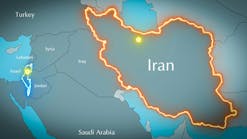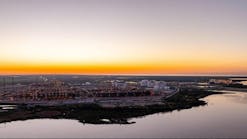Soaring demand for petroleum products East of Suez calls for a construction campaign equal to 40-90 world scale refineries between now and 2010.
That forecast was one of many analyses of the wide downstream sector presented at the Petrotech conference in Bahrain last week.
This first major downstream conference in a region long dominated by production shows where the interest of the world's mightiest producers is directed.
The conference took place in a tense atmosphere resulting from Bahrain's charge that Iran has financed, trained, and introduced armed saboteurs into the small island emirate to overthrow the government.
But this did not dampen the interest in the conference that was strongly supported by Saudi Arabian Oil Co. (Saudi Aramco) and Kuwait Petroleum Corp., which sent top executives to make presentations.
Shell's outlook
Carmine Falcone, head of strategic planning, oil products, for Shell International Petroleum Co., outlined the dramatic scenario and analysis of refining needs of the Asia/Pacific region. It could be an "Asian Century" for refiners, he said.
However, Falcone cautioned that the main challenge to meeting the region's refinind needs will be an economic one.
If refining margins stay at the same level they have historically, it will be unlikely that private refiners will build the needed capacity. So governments will have to enter the picture.
Governments may also present onerous conditions that could scuttle projects.
The historical average margin for hydroskimming refineries and complex refineries has been about $1.50/bbl. To support grassroots (greenfield) construction, margins of $3.50/bbl and $6.50/bbl will be needed for hydroskimming and complex refineries, respectively.
It appears complex refineries will be needed in an era dominated by transportation fuels.
Falcone said recent history shows that most refining capacity growth in the Middle East and Southeast Asia has involved "brownfield" expansions.
A reason is that 40% of the assets in a new plant do not generate margins.
This and the margin outlook are reasons private industry has not jumped in with grassroots projects for the Asia/Pacific.
Abdullah G. Al-Ghanim, senior vice-president of Saudi Aramco, agreed that unless refining margins improve dramatically soon, construction in the Asia/Pacific region will lag growth in product demand.
Where to build
Most observers do not believe the bulk of Asia/Pacific demand will be met by construction in the Middle East. Most refineries will be built near the areas of consumption.
However, there is still plenty of need for expansion in Gulf Cooperation Council (GCC) countries-Saudi Arabia, Kuwait, Bahrain, Qatar, United Arab Emirates, and Oman.
Ali G. Ma'adhah, professor of chemical engineering at King Fahd University of Petroleum and Minerals, pointed out that only 23% of the GCC's production of 13 million b/d is refined in the GCC.
The group has only 4% of world refining capacity. Half of the refined product is exported.
Saudi Arabia has 54% of GCC capacity and Kuwait 26%. This has led producers to invest in refineries outside the GCC, which needs to beef up its conversion capacity.
GCC countries do not produce unleaded gasoline for internal needs.
Saudi Aramco's Al-Ghanim be- lieves construction for unleaded gasoline is desirable. He said, referring to a World Bank study, each $1 invested in making unleaded gasoline saves $10 in health and automobile maintenance costs.
Copyright 1996 Oil & Gas Journal. All Rights Reserved.

